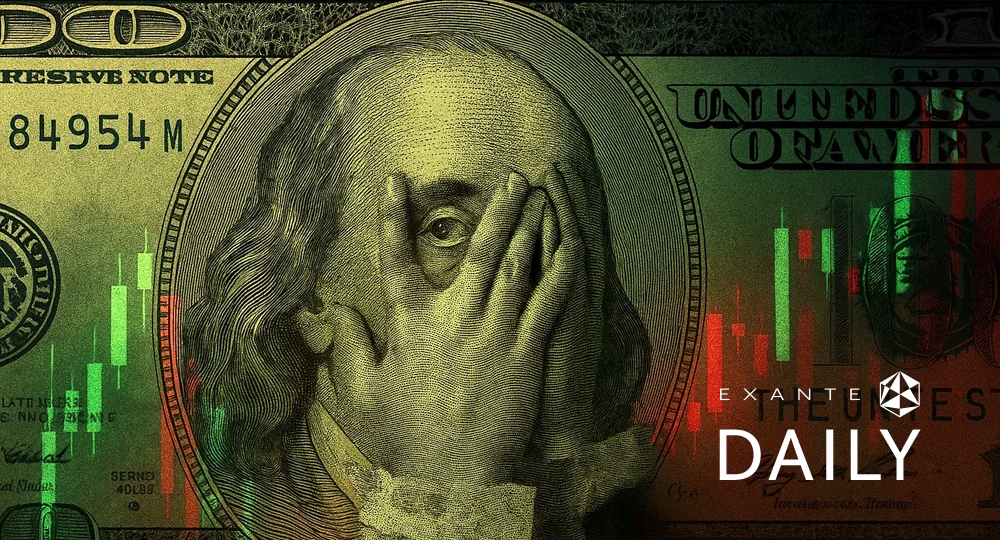
EXANTE Quarterly Macro Insights
.png)
Q4 roundup
The fourth quarter of 2022 saw some recovery in Europe and the US. Government bond yields edged up towards the end of Q4 reflecting concerns over major central banks reiterating plans to continue tightening monetary policy despite some early signs of inflation slowing. Labour markets remained tight in the US, the UK and in Europe in Q4 with the ratio of vacancies to unemployed remaining high and participation rates remaining muted, particularly in the UK, putting further pressure on central banks.
US indices for 2022:
The S&P 500  7.35% in Q4 2022 and
7.35% in Q4 2022 and  19.4% YTD.
19.4% YTD.
The Nasdaq 100  0.27% in Q4 and
0.27% in Q4 and  32.96% YTD.
32.96% YTD.
The Nasdaq  1.03 % in Q4 and
1.03 % in Q4 and  33.10% YTD.
33.10% YTD.
The Dow Jones Industrial Average  15.65% in Q4 2022 and
15.65% in Q4 2022 and  8.58% YTD.
8.58% YTD.
The NYSE  12.71% in Q4 and
12.71% in Q4 and  11.53% YTD.
11.53% YTD.
European Indices:
The DAX  14.93% in Q4 and
14.93% in Q4 and  12.35% YTD.
12.35% YTD.
The CAC40  12.35% in Q4 and
12.35% in Q4 and  9.35% YTD.
9.35% YTD.
The IBEX 35  11.71% in Q4 and
11.71% in Q4 and  5.56% YTD
5.56% YTD
The FTSE MIB  14.81% in Q4 and
14.81% in Q4 and  13.31% YTD.
13.31% YTD.
The FTSE 100  8.09% in Q4 and
8.09% in Q4 and  0.91% YTD.
0.91% YTD.
Bitcoin  65% YTD.
65% YTD.
Ethereum  67.7% YTD.
67.7% YTD.
Note: As of 5:00 pm EST 30 December 2022
US equities made strong gains in Q4, particularly in November, as investors took hope that the pace of Fed tightening might slow amid signs that inflation was cooling with headline inflation dropping to 7.1% in November from October’s 7.7% and September's 8.2% . Annualised Q3 GDP for the US was confirmed at 3.2% in December, above prior estimates, while unemployment remained low at only 3.5%. The labour market seemed to soften slightly as only 263,000 jobs were added in November and 230,000 in December. The Fed’s preferred measure of inflation—core PCE, which excludes volatile food and energy prices—was up 4.7% in November, still well above the 2% target.
In Q4 energy stocks again performed well including Exxon Mobil, Chevron Corporation, and Shell all having record quarters while some of the other best performing energy stocks over 2022, were, according to Bankrate.com, were Occidental Petroleum, Hess Corporation, Marathon Petroleum, Schlumberger Limited, Halliburton, Valero Energy, ConocoPhillips, Marathon Oil Corporation. Consumer discretionary fared badly largely due to the sell-off for Tesla as a consequence of missed market expectations for Q4 deliveries. Growth and tech stocks continued to be battered in Q4 in part because of rising interest rates, inflation, and a strong US dollar. The weakest sectors in 2022 were the communication services sector including stocks like Meta Platforms, DISH Network Corporation, Walt Disney Company, and Match Group as well as real estate including American Tower Corporation, Essex Property Trust, Digital Realty Trust, Vornado Realty Trust, D.R. Horton, Inc., and Ventas, Inc.
Eurozone stocks outperformed other regions in 2022 with energy, financials, industrials and consumer discretionary doing particularly well. More defensive parts of the market such as consumer staples lagged the wider market’s advance. Equity gains were supported by hopes that inflation may have peaked as gas prices fell throughout Q4 to reach pre-Ukraine conflict price levels. However, Europe continued to be negatively affected by the crisis in Ukraine, the impact of the energy crisis, and growing concerns about the increasing likelihood of recession as economic growth softened despite an improvement in supply chains. Its manufacturing powerhouse, Germany, saw a contraction in December as the S&P Global/BME Germany Manufacturing PMI was at 47.1 in December, the sixth consecutive month of falling factory activity.
In the UK, inflation eased to 10.7% in November, down from October’s 11.1% . As noted by JP Morgan, the UK stock market outperformed its peers in 2022. This could be due to its large exposure to commodity producers and defensive consumer staples, both of which performed well in 2022, and its low exposure to technology companies which suffered significantly. The decline in Sterling also helped as most of the companies’ revenues came from outside the UK, thereby boosting the Sterling value of their foreign earnings.
In Asia ex-Japan, stocks were boosted by China’s relaxation of its zero-Covid policy. In Q4 stocks were up 11.4% (MSCI Asia ex-Japan). The decision by the ruling Chinese Communist Party in November to relax its ‘zero-COVID’ policy after weeks of civil unrest in at least 10 major cities, and allow lockdowns in targeted areas only, rather than entire neighbourhoods or cities, as had previously been the case, gave hope to investors that China’s re-opening would ease remaining supply chain constraints.
In Emerging markets, according to the MSCI EM index, equities were up 9.8% in Q4 although this index was down 19.7% for all of 2022. Emerging market equity valuations were trading at near historic discounts in comparison to the developed markets.
2022 REVIEW
Both bond and equity markets experienced extreme volatility in 2022 with the US stock market experiencing its worst year since the 2008 financial crisis. US equities were, at one point, in bear market territory, while bonds experienced the biggest sell-off since 1994. Inflation proved to be far less transitory and far more sticky than the Fed thought early in 2022, forcing it to take far more aggressive rate hikes from May. According to Refiniv data,10-year Treasuries rose about 238 basis points in 2022, its biggest yearly climb since at least 1953. The two-year jumped about 370 basis points in 2022, its largest annual increase since 1972. The Fed now foresees the terminal rate climbing above 5% in 2023 while Fed Chair Jay Powell and other Fed officials have said there may be a need to keep rates at a higher level for longer to tackle inflation.Throughout the latter part of 2022 we saw the inversion of the yield curve with the gap between yields on two- and 10-year growing to 55.3 basis points by the end of 2022, indicating for many including BlackRock, that the US is headed into recession in 2023.
USD strength hit global currencies
Continued Fed tightening along with its status as a safe haven and independent energy producer contributed to the strengthening of the dollar throughout 2022, with the USD reaching 20 year highs. The dollar’s surge against other currencies did negatively affect the earnings of many US companies, making it more expensive for multinationals to convert their earnings back into their home currency.
However the ECB’s new determination to rein in inflation with its series of rate rises in Q4 helped the EUR to recover some ground, although it was still down 5.86% YTD against the US dollar.
The GBP continued to suffer from high inflation, running at 10.7% in November, a tight labour market, and ended the year down 10.68% against the US dollar. The UK government bond market was particularly hard hit in 2022, falling by 25% over the year. This was due to both rising interest rates and failed government policy. The UK’s ‘mini-budget’, unveiled in early September by then Chancellor Kwasi Kwarteng with the support of then Prime Minister Liz Truss, sent a chill through investment markets over the viability of UK debt and caused bonds to nosedive. The Bank of England, in an unprecedented move, stepped in and purchased around £19.3 bn of gilts.
The YEN lost around 12% against the dollar in 2022, as the Japanese authorities were compelled to step into the market in September to prop it up for the first time since 1998 and again in October, when it weakened to a 32-year low of 151.94 per dollar.
What to think about in 2023
There are a number of continuing and new risks to investors in 2023 as the world, according to World Bank estimates, will only grow 1.7% and as up to a third of countries, according to IMF Managing Director Kristina Georgieva, will be in recession. The general consensus is that Europe and the UK will be in recession during 2023, with the UK faring worse due to still rising energy prices, a tight labour market and underlying structural issues, and stickier inflation. While headline inflation seems to have already peaked in the U.S., it might not peak in the Eurozone until the end of Q1 2023 according to Deutsche Bank.
There is some significant disagreement about whether the US will be in recession and just how steep it may be. Goldman Sachs has said that it doesn’t think the US will be in recession as the rapid growth in post pandemic job openings will be easier to unwind, real disposable personal income has rebounded since the first half of 2022, and especially because the financial conditions drag will likely diminish assuming Fed officials do not deliver dramatically more tightening than the rates market is currently pricing in. However others, including HSBC and Fidelity do see the possibility of the US falling into recession in the first part of 2023 while BNP Paribas expects one to begin in the US in Q3 2023. There is also the possibility that China may decide to reinstate its zero-Covid policy measures as death rates rise across the country due to the poor efficacy of its vaccines and distribution, particularly among its more vulnerable, elderly populations. Any further closing would have a knock-on effect on global inflation given China’s importance in global manufacturing processes. And, as noted by Morgan Stanley, growth in China will be weighed down due to its high debt, slowing working-age population growth and declining contribution from trade.
But, as noted by BlackRock, although US inflation may slow as spending shifts back to services from goods, wage growth will keep core inflation higher than before the pandemic. If tight labour markets continue to boost unit labour costs, service sector inflation in particular may linger for longer than investors currently anticipate. Whether or not the Fed will pivot in 2023 is still being debated as much will depend upon if demand driven inflation slows. Even Goldman Sachs admits that a resilient labour market and still elevated inflation, will mean no rate cuts in 2023 unless the economy enters recession after all. As noted by JP Morgan Asset Management, job vacancies will be a key indicator to watch in the next couple of months. If a pivot does indeed take place in the latter half of the year, some market analysts, such as Bank of America, are suggesting that for investors, the best returns may be found in bonds in the first half of 2023 with stocks recovering by the second half of 2023. Credit Suisse also notes that equity markets could still be volatile in the first half of 2023 as slower economic growth hits company earnings. However, Deutsche Bank sees the S&P 500 Index rising to 4,500 in the first half of 2023, before falling 25% in the third quarter and bouncing back to 4,500 by end-2023 as investors front-run a recovery. The general consensus is that US interest rates will be around 5.0% - 5.25% in the first quarter of 2023. The Bank of England may take slightly longer to reach a peak, given that inflation is likely to prove stickier in the UK while the ECB will likely raise rates throughout Q1.
In addition to the macroeconomic uncertainties there are a number of potential risks for 2023 that should be considered including:
-
Energy: Despite the falling price of gas and the redirection of energy supplies from Russia, the problem of energy insecurity in Europe remains as the conflict in Ukraine continues. There may also be further tensions in global energy markets in 2023 due to the US Inflation Reduction Act targeting rapid deployment of new US-centric clean energy supply chains to reduce Chinese influence and cuts by OPEC+ despite growing expectations of rising demand in Asia in 2023 as China continues its slow emergence from Covid.
-
Economic dissonance: This will be reflected in divergence in GDP growth rates due to continuing labour market issues, e.g., falling participation rates in the US due to demographic changes, low participation rates in the UK, and continuing structural employment issues in Europe. There is also the potential hit to bond markets via fiscal policy transfer financing and widening spreads with these having particular political ramifications in Europe.
-
Geopolitical relations/global security environment: Tensions between China and the US may get worse in 2023 with a war of words and legal actions over the semiconductor industry and US laws prohibiting Chinese supply. Any potential military conflict over the Taiwan Strait may lead to a further decoupling of the US and Chinese economies. Taiwan is a dominant player in the global semiconductor industry so if tensions were to rise further between Taiwan and China or between the US and China, it would have a disastrous impact on the global economy. Container shipping and manufacturing would also be negatively affected. There is also, of course, the continuing sanctioning and isolation of Russia by Europe and the US over the conflict in Ukraine. There is also the ongoing tensions between the US and Iran over its nuclear programme. Iran has previously disrupted maritime traffic in the Strait of Hormuz – where 30% of both global crude and LNG pass through – and the Bab Al Mandeb Strait, the world’s fourth busiest waterway that connects Europe to Asia. An increase of tensions with Iran could prompt trade to collapse as routes are shut and shipping costs rise, feeding through into global inflation.
-
Climate change: ESG concerns will not fade as we move into 2023. As noted by Deutsche Bank an overarching concern, with major investment implications, will be the environment. Investors should anticipate these changes as the energy transition (to greener sources of power) and infrastructure demand increases, e.g., the US’ Infrastructure Investment and Jobs Act, and the Inflation Reduction Act, which will direct nearly USD 400 billion in tax credits and subsidies for numerous clean energy programmes.
Investors may also start to show greater concern than corporate earnings estimates may not have fully factored in the expected global slowdown. As noted by Morgan Stanley, holding policy rates high while the economy is slowing can result in lower earnings, falling margins and rising default risks, all of which can have adverse effects on equity and credit valuations. Essentially there is more downside risk for stocks in 2023. With higher yields very likely to continue through the year and potential concerns around profit growth hitting growth stocks, the question for many investors may possibly be whether value stocks,represented by financial, energy and defensive groups, could outperform again this year.
Economic and Geopolitical Risk Calendar:
The potential policy and geopolitical risks for investors that could may negatively affect corporate earnings, stock market performance, currency valuations, sovereign and corporate bond markets and cryptocurrencies include:
16-20 January 2023 World Economic Forum Annual Meeting. Leaders from government, business and civil society will convene to address the state of the world and business in the year ahead in Davos, Switzerland. The theme is “Cooperation in a Fragmented World” with COVID-19 pandemic and Ukraine conflict impacts being central issues.
18 January 2023 Bank of Japan meeting. The BoJ stunned markets when, in December, it imposed a yield ceiling on its bonds of 0.50% for its 10-year bonds. The central bank has a standing daily offer to buy unlimited amounts of 10-year notes and futures-linked securities at 0.50%. However, it is unlikely that the BoJ will change its policy during the January meeting as it will probably want more time to see if volatility will decrease.
22 January 2023. Chinese Lunar New Year. By law people in China get seven days off beginning New Year’s Eve and the celebrations span 16 days. With the lifting of Covid restrictions, expect to see a spike in Covid infections as mainland China opens to Hong Kong, it ends quarantine for visitors and millions begin holiday-period travel.
31 January - 1 February 2023 US Federal Reserve Monetary Policy meeting. The pace of rate hikes will be largely dependent on how quickly inflation comes down. Although several Fed policymakers including Atlanta Fed President Raphael Bostic and San Francisco Fed President Mary Daly have stated the Fed is likely to raise rates to around 5%, the pace or even future pivot of rate hikes will really depend on changes in core inflation and what happens in the labour market.
2 February 2023 ECB meeting and monetary policy decision. The ECB will continue to be data led and despite a downward trend in headline inflation across the Eurozone, core inflation remains stubbornly high. This has prompted ECB PResident Christine Lagarde to state that the ECB will raise rates by 50 basis points in March with a strong likelihood of additional rate rises in subsequent meetings.
2 February 2023 Bank of England Monetary Policy meeting and monetary policy report. The BoE is widely expected to raise rates by 50 basis points to 4%. The BoE’s chief economist, Huw Pill, has said the UK is in an unusual position relative to the US and Europe as it has been suffering from higher natural gas prices with a tight labour market, adverse labour supply developments, and goods market bottlenecks. He believes this creates the potential for inflation to prove more persistent.. The BoE is wary of a “self-sustaining momentum” as workers demand higher wages and companies continue to raise prices to offset costs. Bank governor Andrew Bailey has suggested that further increases in rates are likely if there is no real break in price rises.
5 February 2023 Russian refined oil ban. The EU implements its ban on Russian refined oil products, including diesel, increasing the likelihood of shortages due to low domestic production capabilities.
16 March 2023 ECB meeting and monetary policy decision. The ECB is expected to begin its programme of quantitative tightening (QT) in March, but matters will be complicated by the number and size of new Eurobond issuances by at least 10 member states, causing a growing divergence in yields and contributing to fears of political friction.As noted by HSBC the hawkish tone of the ECB, coupled with the new Italian government, may test investors’ nerves in the Eurozone’s periphery.
21-22 March 2023 US Federal Reserve Monetary Policy meeting. Much will depend on whether core inflation has fallen sufficiently for the Fed to slow down or even pause its rate rises. Markets will be watching labour market numbers closely to see if the Fed can indeed engineer a soft landing without unemployment rates skyrocketing.
23 March 2023 Bank of England meeting and monetary policy decision. The BoE policymakers will likely be forced to continue the rate hike cycle as inflation remains stubbornly high.
DISCLAIMER: While every effort has been made to verify the accuracy of this information, EXT Ltd. (hereafter known as “EXANTE”) cannot accept any responsibility or liability for reliance by any person on this publication or any of the information, opinions, or conclusions contained in this publication. The findings and views expressed in this publication do not necessarily reflect the views of EXANTE. Any action taken upon the information contained in this publication is strictly at your own risk. EXANTE will not be liable for any loss or damage in connection with this publication.
本文提供给您仅供信息参考之用,不应被视为认购或销售此处提及任何投资或相关服务的优惠招揽或游说。金融工具交易存在重大亏损风险,未必适合所有投资者。过往表现并非未来业绩的可靠指标。




